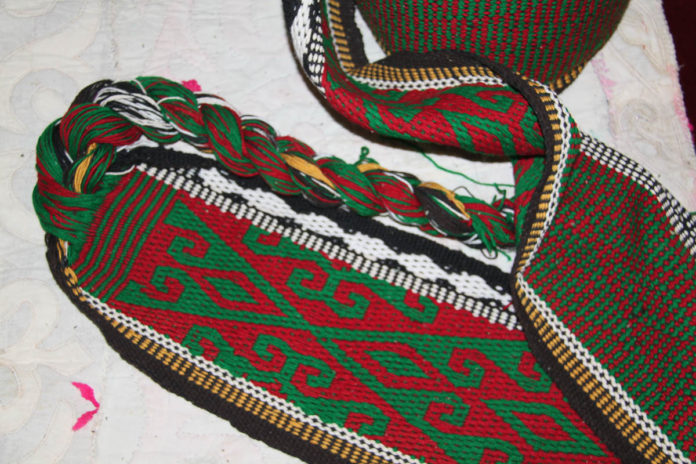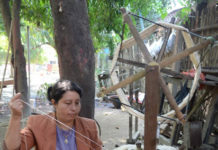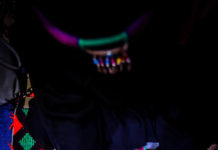Kirghiz weaving occupied an important place in past domestic craft production. The main raw material for weaving was the wool of local sheep. In the south of Kyrgyzstan sometimes cotton was used. In the process of weaving, preparation of the yarn with the help of an archaic spindle iyik requires the greatest expenditure of labor and time. For different types of weaving, yarn of varying degrees of twist and thickness should be produced.
The fabrics produced by the Kyrgyz can be divided into three types: simple monophonic or striped (tar), patterned stripes (in terme, kajary and besh keshte techniques) and big carpets with pile (jule kilem) and lint-free (arabi kilem).

Out of monophonic and striped woven bands, tar outer garments were sewed. The patterned strips were woven on a primitive horizontal machine. The strips were sewn together to form covers, wall hangings and floor carpets. Blankets, saddlebags and courtyards were also sewn from patterned stripes. Today only terme still exists; kajary and besh keshte techniques have almost disappeared. Woven strips were produced of different width (from 4 to 70 cm), depending on the purpose of their usage. The terme strips measuring from 4 to 12 cm, so called boo, and broader strips (kerege tanuu) are used as belts in the yurt construction.
Motifs common in woven items are kaikalak (curl), tay tuyak (foal’s hoof), pychak uchu (tip of a knife), it taman (dog’s paw), ala monchok (motley bead).
Carpets woven as one piece (jule kilem and arabi kilem) were developed and now are produced particularly in the southern part of Kyrgyzstan. Carpets of large size (usually 2×4 or 3x5m) were woven collectively on a simple horizontal loom ducon. The raw material was used: yarns developed of wool of the local sheep, camel and goat and little use of cotton yarns. For colouring, vegetable dyes were used, and from the end of the nineteenth century, aniline dyes replaced them. The predominant colours are all shades of red in combination with blue or black. Other colours were used in limited quantities.
Carpets were ornamented with geometric, plant and horn-like patterns. In the past, among southern Kyrgyz carpets arabi and jule were an obligatory part of the bridal dowry.
By the end of the twentieth-century weaving in Kyrgyzstan almost disappeared due to the lack of a market. At present, in connection with the development of touristic industry and growing demand for yurts, the production of the woven patterned strips in terme technique began to be revived. Only a limited number of women in several villages of the Batken province are engaged in weaving jule and arabi carpets. Carpets woven from the dyed wool of natural colours became fashionable among the new generation of Kyrgyz. Craftspersons who are weaving these rugs include Monuz Topchubayev (Chui province), Bunisa Termechikova (Alay districr, Osh province), Anarkan Turdubayeva and Totu Gulbayeva (Batken province).
Sources
Malchik A.Y. The history of Kyrgyz folk arts and crafts: the evolution of Kyrgyz ornament from ancient times to the twentieth century. – B .: Kyrgyz State University, 2005.





